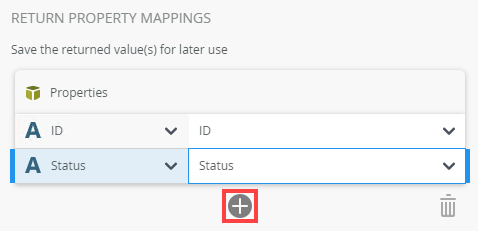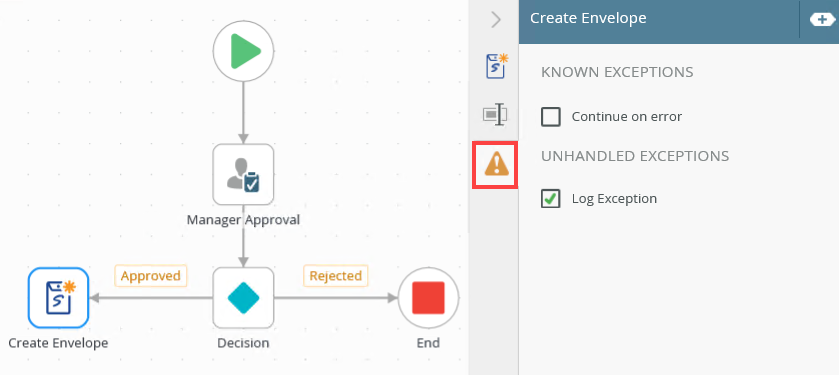DocuSign - Create Envelope step
Use the Create Envelope step to create a new DocuSign draft envelope. This can be assembled over the course of time until it is ready to be sent. This step is typically the starting point when building a workflow containing DocuSign steps.
Knowledge of how DocuSign works is required to use the DocuSign integration provided by the product. You may learn more about DocuSign from the DocuSign website at https://www.docusign.com.
You can, for example, use the Create Envelope step in a workflow as part of an Employee Onboarding workflow. The first step would be for a candidate to sign a contract of employment. Use the Create Envelope step to create a new envelope containing the contract to be signed. The contract document is then added to the envelope in a later step in the workflow using the Add Document wizard.
Drag the Create Envelope step from the DocuSign category, Favorites bar, or the Recent category onto the canvas.
Example of a Create Envelope step in a workflow

- From the Toolbox click the DocuSign category, the Envelope category and then drag the Create Envelope step onto the canvas.
 For more information on how to use the error console, see the Error Console topic.
For more information on how to use the error console, see the Error Console topic. - Select the added step and click the expand / collapse toggle to expand the Configuration Panel. You can also double click the step to expand the panel.

- Select the Create Envelope tab. Use this tab to select the DocuSign service instance, envelope template, envelope options, and the notification and return property mappings.

- Allow Reassign
- Allow Recipient Recursion
- Authoritative Copy
- Enable Wet Sign
- Envelope Id Stamping
- Allow Mark-up
- Asynchronous
- Auto Navigation
- Enforce Signer Visibility
- Message Locked
- From the DocuSign Service menu, select the service instance. Select Standard Envelope or Use Template.

- If you use a standard envelope, select additional attributes from the Standard Envelope Option section. Check the Use Brand check box to enable the menu. Select a brand from the menu and select one or more DocuSign attributes.

- If you use a template, use the Notification section to customize the notification. Use the Subject and Body fields to customize the message.
Type values or create dynamic values by dragging Functions,
Fields,
SmartObjects and
Workflow-related items from the Context Browser into the fields.

- Configure the Return Property Mappings. Click Add to add properties. Select a value from the property menu.

- To add additional properties, click Add.

- To delete properties, select them and click the Trash bin.

- With the step selected, select the Properties tab.

- Click the Errors tab.

- The exceptions in the table above is an example of those available in Workflow steps. The exceptions available depend on the Workflow step used in the design canvas.
- When you enable both Continue on Error and Force error when required SmartObject inputs are missing, the workflow continues with execution even if the required inputs are missing. The Continue on Error setting takes precedence.
Your changes are automatically saved.
The following table explains the options available on this tab:
| Option | Explanation | How to Use |
|---|---|---|
DocuSign Service | This is the service instance you registered to integrate with the product. You can register multiple service instances when needed, but only one is required. In the case where you have multiple service instances, and you have templates in another service instance, make sure the templates created in DocuSign are shared if you need them available for all service instances. | Select the service instance from the menu. |
| Standard Envelope | Allows you to create a standard DocuSign envelope. | Select the Standard Envelope radio button. |
| Use Template | Allows you to create a new envelope based on a template. This option is useful if you have templates defined for each business purpose. | Select the Use Template radio button. Select the template from the menu. |
| Standard Envelope Options | ||
| Use Brand | Allows you to use a specific brand created in DocuSign. Available brands are listed in the menu. | Select the brand from the menu. |
| Additional Options | A list of available DocuSign attributes are available when a Standard Envelope is used, and include: You can select one or multiple options. This is not required to create a new envelope. | Check the check boxes to select the options. |
| Subject | Use this field to add a subject to the message. Available for both Standard Envelope or Use Template option. This is a required field. | Type values or create dynamic values by dragging Functions,
Fields,
SmartObjects and
Workflow-related items from the Context Browser into the fields. When a SmartObject Load method property is used, an input property is required for the correct data to load. |
| Body | Use this field to add customize the body of the message. Available for both Standard Envelope or Use Template option. | Type values or create dynamic values by dragging Functions, Fields, SmartObjects and Workflow-related items from the Context Browser into the fields. |
| Return Property Mappings | Return properties listed here are mapped to variables. This allows you to make use of these values in other steps in the workflow. Create a field and drag it from the Context Browser to the return property. The value of this property is stored in the variable for each workflow instance. | Select properties and supply return values. Type values or create dynamic values by dragging Functions, Fields, SmartObjects and Workflow-related items from the Context Browser into the fields.When a SmartObject Load method property is used, an input property is required for the correct data to load. Click Add to add additional property fields. |
The following table explains the options available on this tab:
| Option | Explanation | How to Use |
|---|---|---|
| Title / Name | By default, each step on the canvas has a step title. You can change this title to suit your workflow logic and show it on the canvas by checking the Show Label box. | Enter a value into the Title/Name field. |
| Reset link | Use the link to reset any changes to the title. | Click the Reset link to reset the Title/Name field to default value. |
| Show Label | Allows you to see the step label on the canvas. The label shows the value of the title. | Check the check box to display step label on the canvas. |
| Description | Allows you to add a detailed description for the step. | Enter a value into the Create New field. |
| Notes | Allows you to add additional notes for the step. | Enter a value into the Notes field. |
Different types of exceptions can occur on a step, such as:
| Type | Description |
|---|---|
| Known exceptions | Any SmartWizard or standard wizard that has Boolean options for handling known exceptions have these options displayed as check boxes in the Known exceptions section of the Exceptions tab. |
| Unhandled exceptions | Any unknown runtime exceptions. |
The tab contains the following known exceptions:
| Exception | Explanation | How to Use |
|---|---|---|
| Continue on error | On step execution and an error occurs, continue to the next step in the workflow. | Check the check box to continue if an error occurs. Uncheck the check box to stop workflow execution if an error occurs. |
The tab contains the following unhandled exceptions:
| Exception | Explanation |
|---|---|
| Log Exception | Logs the exception to the error log. |
| Force error when required SmartObject inputs are missing | Will forcefully throw an error if a SmartObject method has input missing. |
| Continue on error | Will force the workflow to continue running the SmartObject method, even if it runs into an error. |
When working with the Create Envelope step keep in mind the following consideration:
- The DocuSign Service Instance must be registered before using this wizard. For information on how to do this, see DocuSign feature activation.
- Use the Create Envelope step first, which is typically the starting point when building a workflow containing DocuSign steps